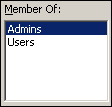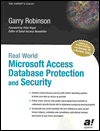databasedev.co.uk - database solutions and downloads for microsoft access
Microsoft Access Articles
- General Microsoft Access Articles
- Microsoft Access 2007 Articles
- Tables
- Queries
- SQL
- Forms
- Reports
- Macros
- Modules & VBA
- Data Models
- Downloads
GUI Design
Resources
Online Shop
Info
Microsoft Access Database Security
Changing a Password:
Now that you've created new Microsoft Access User Accounts, it's time to look at Security Account Passwords.
Passwords that are entered when you log on to Access are known as Security Account Passwords. The primary purpose of these passwords is to ensure that no other user can log on using your name. If this is the first time you are adding a password to your Access account, you do not have to use the Old Password text box.
The Admin user has full permissions to all database objects. The Admin user’s password is empty, so anyone can log on to Access as the Admin user. To make your system more secure, you can remove the Admin user from the Admins group. In this tutorial, you'll do just that.
Task A-5: Setting your logon password and removing the Admin user from the Admins group
Objective: To add a password for yourself and to delete the Admin user. This information relates to the sample Microsoft Access database download
- Exit Access.
- Start Access. Don't open a database.
- Choose Tools, Security, User And Group Accounts. The Logon dialog box opens.
- Log on by using your name (as you typed it in when you created your own user account) and no password. There's no password assigned to your name yet. After you click OK, the User And Group Accounts dialog box opens.
- Select the Change Logon Password tab.
- In the New Password and Verify text boxes, type password.
Remember, the password is case-sensitive.

- Click Apply to accept the change and leave the dialog box open.
- On the Users page, select the User Name Admin.

- From the Member Of list, select Admins.

- Click Remove to remove the Admin user from the
Admins group. The Admin user remains a member of the Users group
only.

- Click OK to accept the change and close the User And Group Accounts dialog box.
Next we'll take a look at The Security Wizard.
Go to page:
- Steps to Securing an Access Database by Using User-level Security
- Setting Logon Procedures
- Group Accounts
- User Accounts
- Changing a Password
- The Security Wizard
- Permissions
- Testing Security
- Documenting Database Security
- Previewing Permissions
- Securing a Database with a Database Password
- Distributing the Secured Application
Recommended Reading:
If you are serious about your Microsoft Access security, then you should check out Garry Robinson's book Real World Microsoft Access Database Protection and Security
About the book:

Microsoft Access is the most popular desktop database in the world today and its very popularity means that its security measures can be easily compromised. Real World Microsoft Access Database Protection and Security takes a different approach than all the other Access books in the market by focusing from the start on all the issues that will help protect your database. It approaches protection and security from a task-by-task perspective and provides details that when put together will make your database more secure.
This book will help you to keep your staff from looking at your salary tables, stop your customers from looking at the design of your software that you distribute, and help you decide which security options are worth doing and which are generally a waste of your time.
Garry writes from a very experienced developer's point of view and he discusses in detail how to program all types of security issues including hiding tables as system tables, producing databases that password cracker software cannot easily crack, backing-up databases, menus, queries, and even user surveillance.
- Real
World Microsoft Access Database Protection and Security
[From Amazon UK]
- Real
World Microsoft Access Database Protection and Security
[From Amazon US]